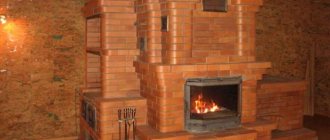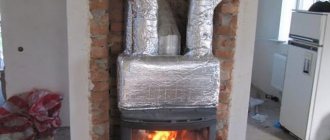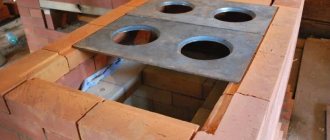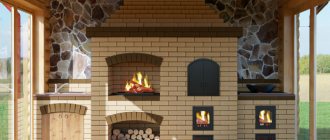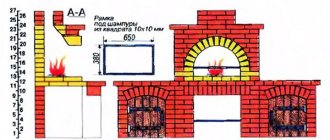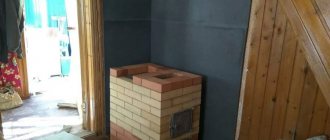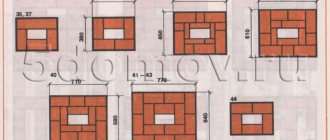The classic means of heating in a country house in Russia has been a brick stove since ancient times.
Brick heating stove with natural finish and gray seams
Despite rapidly developing technologies, the stove still remains a reliable tool that effectively improves comfort in the home. Of course, now you can buy electric or gas heating or cooking appliances, but nothing compares to a traditional brick stove, with which you can heat your house and cook delicious food. They will fill your home with cozy warmth from a living dancing fire, and food cooked on them will have a unique taste.
Types of heating and cooking stoves
Heating and cooking stoves for country houses can be very diverse. They come in a variety of sizes to suit a variety of homes.
The hob, like the oven itself, can be made of different materials that suit you. Let's consider all possible options for heating and cooking stoves.
Swedish masonry
In general, the construction of a Swedish heating and cooking stove does not differ from the construction of other stove structures. You should start working by preparing a place - for Swedish stoves it is chosen either in the wall between the kitchen and the room, or in the corner near two adjacent walls. Walls must be protected from high temperatures. To do this, they are lined with any fire-resistant material, for example, ceramic tiles.
Work on any furnace begins with preparing the foundation. Depending on the design of the heating device, the foundation may differ, but in any case it must be reliable in order to withstand considerable weight. It is carried out in a pit, the size of which exceeds the dimensions of the future furnace by at least 10 cm. A pit about 30 cm deep is sufficient to ensure the reliability and safety of the structure.
Crushed stone and broken brick are laid in layers at the bottom of the pit. The layers are carefully compacted and filled with cement mixture. After the concrete has hardened, a layer of waterproofing is laid flush with the floor. On crumbling soils, it is worth making formwork, which is removed after the cement mixture has completely hardened.
It is important that the surface of the foundation is level and strictly horizontal.
The foundation is ready and the stove can be installed. The laying is carried out in accordance with the chosen order. The versatility of Swedes has given rise to a huge number of orders. The appropriate option is selected depending on the specific conditions and architectural features of the house.
Despite the variety of masonry patterns, there are a number of rules that must always be strictly adhered to.
Masonry rules
- If the order provides for technological voids, they can be filled with broken bricks. Smoke ducts should not be made with right angles. It is better if all corners are rounded. This will ensure normal movement of flue gases in the furnace.
- During laying, it is imperative to control the verticality of the corner bricks. Even the slightest deviation will cause the stove to tilt. This is not only an aesthetic problem - one can only guess about the degree of reliability and efficiency of a crooked stove. Corner bricks are beacons during laying.
- To ensure good adhesion, the bricks must be moistened with water before laying. You can't wait for the brick to dry. Immediately after wetting it must be used in masonry.
- Expansion joints must be provided in places where metal elements are installed. It is better to reinforce the seam where the doors are installed with steel wire. Otherwise, there is a high risk that the door will simply fall out during operation of the oven.
- The fully folded oven should dry thoroughly. The first fire is carried out after the masonry has dried, and then the stove needs to be heated for about 2 weeks.
Brick oven
The most common options are heating and cooking stoves made of brick. One of the disadvantages of such a stove is the complexity of its construction. A person without construction experience cannot build a heating and cooking stove with his own hands.
It is better to contact a professional stove builder, he will build the structure of the stove and build a chimney.
- Brick stoves take quite a long time to warm up the room; after starting the fire, you will have to wait a while for the room to warm up.
- The advantage of a brick stove is that the brick gives off heat for a long time, despite the fact that the coal in it has already burned out.
- If you rarely visit a country house during the cold season, a brick oven is not suitable for such purposes. It is cracking and requires repair.
- It is better to use it constantly; short breaks in operation are allowed.
The design of a brick oven can be very different, large, small, equipped with a stove bench. Heating and cooking stoves with an oven can also be built in a summer house.
In a summer house, you can build a barrel of water into a brick oven. Its purpose can be very different. Heat water for personal use or perform an additional heating function at home.
Popular mistakes
It is better to wet the bricks before laying.
Inexperienced craftsmen put dry bricks into the masonry, but it is better to wet the material. It holds better and adheres more firmly to the solution. This results in more accurate and even masonry joints. Use a wide bucket of water, where the elements are placed for 2 - 5 minutes before installation.
Narrowing the smoke channel in relation to the standard size reduces draft, and damp wood will not burn. When installing the fire chamber door, they often do not leave a 0.5 cm gap around the perimeter to compensate for expansion. After installation, the gap is filled with asbestos cord or sand mortar.
Iron partitions are placed inside the furnace, but it is better to use bricks placed on edge. This is explained by the different expansion of ceramics and metal.
The oven cavity cannot be placed close to the firebox; it is better to place it above the heating chamber through the decks. This will heat the bottom evenly, and the baked goods will be baked equally on all sides.
Steel furnaces
The advantage of steel stoves is the rapid heating of the structure and the room; as soon as the coal burns out in the stove, it quickly cools down and the room quickly begins to cool down.
To maintain the temperature, it is necessary to constantly add coal or wood to the stove.
- The problem of quick cooling of a steel furnace can be solved using bricks.
- By covering a steel stove with bricks, you will significantly increase the heating time of the room. As you know, brick gives off its heat for some time after the firewood burns.
- Some steel furnaces are equipped with a conversion system. Cold air enters the oven from the bottom and heats up from the top.
In some steel stoves, wood can burn for a long time; this can be from 8 to 10 hours. They smolder and release gas, which also burns to form heat. This effect is achieved using a built-in pyrolysis chamber.
Preparing the necessary tools
During laying, you need to control the verticality of the walls and the horizontality of the rows. To do this, use a building level, a plumb line, and a carpenter's square.
Other tools:
- trowel, pickaxe;
- tape measure, pencil;
- drill with whisk;
- grinder with cutting wheel for stone.
For even masonry, use a device called ordering. This is a wooden or steel strip on which the installation locations of each brick are marked with marks or notches.
A cord is used, which is pulled after installing the corner elements; it outlines the top of the stones of each row.
Cast iron stoves
The advantages of a cast iron heating and cooking stove are the rapid heating of the room, similar to a steel stove; just like brick stoves, it gradually releases its heat after the wood burns out.
Cast iron stoves confidently hold second place among all options. In some points they are superior to brick and steel stoves, but there are also nuances in which they are inferior.
Cast iron stoves are very easy to use; with long-term use they are not subject to destruction and do not rust. After a long break in operation, they work without any defects, performing their function perfectly.
Cast iron stoves are very expensive and cannot be made independently.
Swedish masonry
In general, the construction of a Swedish heating and cooking stove does not differ from the construction of other stove structures. You should start working by preparing a place - for Swedish stoves it is chosen either in the wall between the kitchen and the room, or in the corner near two adjacent walls. Walls must be protected from high temperatures. To do this, they are lined with any fire-resistant material, for example, ceramic tiles.
Work on any furnace begins with preparing the foundation. Depending on the design of the heating device, the foundation may differ, but in any case it must be reliable in order to withstand considerable weight. It is carried out in a pit, the size of which exceeds the dimensions of the future furnace by at least 10 cm. A pit about 30 cm deep is sufficient to ensure the reliability and safety of the structure.
Crushed stone and broken brick are laid in layers at the bottom of the pit. The layers are carefully compacted and filled with cement mixture. After the concrete has hardened, a layer of waterproofing is laid flush with the floor. On crumbling soils, it is worth making formwork, which is removed after the cement mixture has completely hardened.
It is important that the surface of the foundation is level and strictly horizontal.
The foundation is ready and the stove can be installed. The laying is carried out in accordance with the chosen order. The versatility of Swedes has given rise to a huge number of orders. The appropriate option is selected depending on the specific conditions and architectural features of the house.
Despite the variety of masonry patterns, there are a number of rules that must always be strictly adhered to.
Masonry rules
- If the order provides for technological voids, they can be filled with broken bricks. Smoke ducts should not be made with right angles. It is better if all corners are rounded. This will ensure normal movement of flue gases in the furnace.
- During laying, it is imperative to control the verticality of the corner bricks. Even the slightest deviation will cause the stove to tilt. This is not only an aesthetic problem - one can only guess about the degree of reliability and efficiency of a crooked stove. Corner bricks are beacons during laying.
- To ensure good adhesion, the bricks must be moistened with water before laying. You can't wait for the brick to dry. Immediately after wetting it must be used in masonry.
- Expansion joints must be provided in places where metal elements are installed. It is better to reinforce the seam where the doors are installed with steel wire. Otherwise, there is a high risk that the door will simply fall out during operation of the oven.
- The fully folded oven should dry thoroughly. The first fire is carried out after the masonry has dried, and then the stove needs to be heated for about 2 weeks.
Type of fuel
Stoves in country houses can be heated in two different ways.
- Solid fuel;
- Universal.
Solid fuels include coal and firewood. They are superior to electric and gas.
Heating with gas or solid fuel can be considered universal. In this case, when one fuel runs out, you can switch to another. From gas to wood or coal and vice versa.
How to make a tandoor
The most important part for making a stove is the cauldron. You should choose the largest and deepest. It needs to be placed upside down, greased with sunflower or olive oil and wrapped in paper sheets. Then a special mixture is prepared: clay is mixed with sand in proportions 1:2, a small amount of wool is added. This solution is coated with the outer surface of the boiler. A hole with a diameter of 40 cm is left in the upper part. The layer of the mixture should be quite thick - about 8 cm, and closer to the base - 10 cm. Be sure to let the product dry for 7-10 days.
There is another way to make a casing: a thick solution is rolled out onto rollers (5 cm in diameter), and then tier by tier is wrapped around the cauldron. For the strength of the structure, it is necessary to tightly connect the resulting turns to each other - press them with your fingers and make tucks. After drying, the cone is removed from the cauldron and placed on a brick or stone foundation. A blower is made at the bottom of the furnace. In Asian countries, adobe is used for the foundation - a building material consisting of clay, straw and various additives.
You can decorate your creation with figures and patterns sculpted from mortar. Next, the tandoor should be fired - close the lid, heat it with dry wood and leave to cool slowly. Such a product will become the pride of the owner of the dacha, because he created it with his own hands.
Criteria for choosing a stove
If you decide to heat your house using solid fuel, you must choose a stove based on a number of characteristics.
- Power. The stove must heat all rooms in the house. A large and massive stove will consume a lot of fuel. A small stove will not be able to heat the house completely.
- Furnace wall thickness. The wall thickness of the steel furnace should be within 4-6mm. The hob must be made of cast iron.
- Oven manufacturer. An important quality of a stove is its manufacturer. play it safe and buy the stove from a reliable seller. When buying a stove on sale, you risk buying a low-quality product that will not last long.
Brick edges and parts
Faces and parts of a brick
The end of a brick is called a butt, the wide flat side is called a bed, and the side surface is called a spoon. The ribs of the product are called the usenka. Masonry is carried out by placing the product on a bed, which is considered a working surface. In the only option, the elements are placed on spoons if the wall is built with ¼ brick.
Parts of stones other than full bricks are intended for making corners and turning walls and have conventional names:
- three-four (nine);
- four (quad);
- half.
The brick is divided into pieces with a pick, hitting the spoon rather than the bed, while the stone is held leaning on its edge. A small volume of incomplete factory-produced elements is ordered from the supplier.
Heating and cooking stove for a summer residence
When buying a heating and cooking stove for a country house, you need to consider a number of factors:
- Country houses are small in size, about 100 m2. While in the store, before purchasing a stove, carefully read the stove data stated by the manufacturer. Consult with the seller to discuss the characteristics in more detail. Select a stove with a power suitable for heating your country house.
- Select the type of irrigation that you will use to heat the building. The best option is considered to be universal ovens with a convection system. If desired, you can purchase a stove with fireplaces, adding comfort to your country house.
- Expenses. It is better to pay once to purchase a complete stove with a barrel oven for heating water and a fireplace, and a cast iron hob. In the kit, high-quality components will cost less. Rather than purchasing each component separately.
Buying a heating and cooking stove is quite a crucial moment, with a number of difficulties and nuances. There are various options for stoves with cast iron hobs on sale.
When choosing a stove, you need to base it on power and price category.
Swede is the best solution
Perhaps the best cooking and heating stove for centuries has been the Swedish one.
Note! In terms of its design, it is much simpler than Russian stoves, but in terms of efficiency, efficiency and versatility it is in no way inferior to it. These stoves embodied the harsh life of the ancient Scandinavians
The devices heat the house and are great for cooking, drying clothes and storing kitchen utensils. You can easily attach a bed to the Swedish bed or make a combined structure with a fireplace. No other stove is as multifunctional and at the same time simple as the Swedish one
These stoves embodied the harsh life of the ancient Scandinavians. The devices heat the house and are great for cooking, drying clothes and storing kitchen utensils. You can easily attach a bed to the Swedish bed or make a combined structure with a fireplace. No other stove is as versatile and at the same time simple as the Swedish one.
Heating devices of this type have considerable advantages:
- Versatility. The Swede is a universal stove in the full sense of the word. There is not a single function that Swedish ovens cannot do.
- Compactness. Compared to Russian stoves, Swedish stoves are small in size. They do not take up much space, save usable space and at the same time show the efficiency characteristic of massive furnace structures.
- Simplicity. It is simply impossible for a person who is not a qualified stove maker to build a Russian stove. The situation is completely different with the Swede. You can take a ready-made project and order as a basis, so that the result is a unique heating device that meets specific operating conditions.
Photo of heating and cooking stove
Requirements for the arrangement of shields
It is important to remember the strength of the foundation and its high-quality waterproofing (for example, with a layer of roofing felt). This will prevent moisture from getting on the shield.
It is also necessary to strictly take into account all fire safety requirements.
To prevent the formation of excessive condensed moisture and reduce draft, it is necessary to control the maximum temperature of the exhaust smoke, which should be no more than 120 degrees.
Features of materials
It is better to build the chimney wall from smooth and chip-free brick. All joints between rows, all seams must be properly and evenly sealed with mortar. The solution that has fallen down the unit should be removed from there through special openings to clean the oven.
The ideal size for laying the shield is considered to be half a brick in size, which prevents it from cooling quickly.
To build the shield, it is permissible to use ordinary brick. The only condition is that it should not be hollow. It is better to seal the seams between layers of brick not with cement mortar, which is not adapted to the influence of high temperatures, but with a clay mass.
A correctly folded heating shield increases the efficiency of the stove from 30% to approximately 65%.
